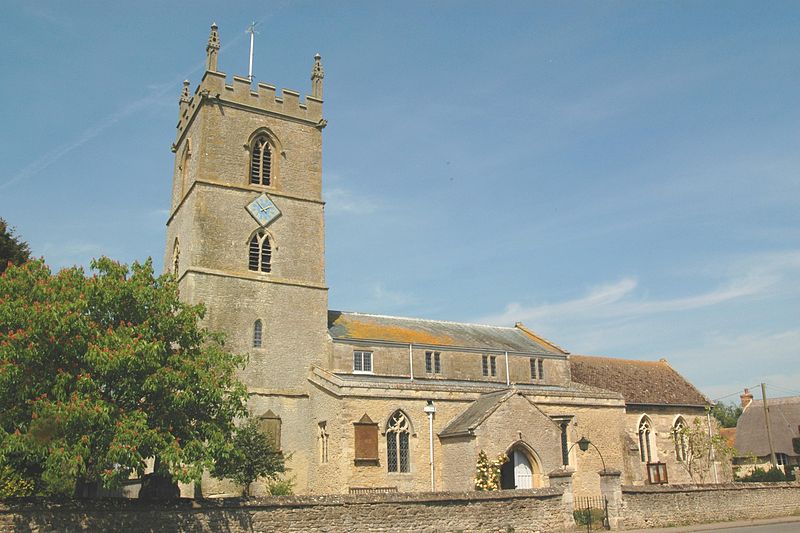Arthur Mee - The King's England, Oxfordshire.
Charlton-on-Otmoor – Bad News for a King.

In the churchyard are the remains of a 13th Century cross. The old south porch encloses a 13th century doorway, in which hangs a door on ancient strap hinges with a wooden lock a yard long. Above it is a traceried niche, with three canopied brackets. Much of the interior is 700 years old, including the font and the piscina. Over the arches of both arcades, over a window, and round some of the pillars, patches of 13th century painting are fading away.
The 14th century chancel has three fine stone seats. In the floor, which has some very old tiles, is the tombstone of John de Craneford, a 14th century rector, and a portrait brass of Thomas Key, a 15th century rector with a rich cope. All the chancel windows have fragments of ancient glass, the east window showing a crowned Madonna in red and green robes, with the Child on her knee. Among the church plate is a 17th century silver chalice given by Thomas Lamplugh, a rector who changed sides as often as the Vicar of Bray. He was King’s man, Commonwealth man, and Royalist again by turns, always profiting by the change. As Bishop of Exeter he hastened to London in 1688 to warn James the Second that William of Orange had landed, and was rewarded with the archbishopric of York; he gained a throne for telling a king he was losing one. On James’s flight Lamplugh was one of the first to swear allegiance to William and helped to crown him. He sleeps in York Minster.
The proudest possession of the church is the beautiful 15th century screen, which has two rows of linenfold at the base, richly carved uprights between the traceried bays on either side of the fine gates, and 28 panels of delicate tracery in the canopy. Much of it is still bright with the original colour.
This is one of the few villages where the customs of Merrie England are still observed. When we were here a great cross of fragrant flowers and sprays of box had been brought in by white-clad village maidens and placed on top of the screen, according to an immemorial May Day custom of the village.
W. Hobart Bird – Old Oxfordshire Churches.
There is a tall, restored churchyard cross. The church is of much interest. Dedicated to St. Mary the Virgin, it comprises quire, clerestoried nave, aisles, South porch and lofty embattled West tower, with crocketed pinnacles at the angles. It is of four stages, Early English and early Decorated with a Perpendicular top stage. The lower stage has a plain lancet light, which is rebated for a shutter. The South aisle has a good parapet of sunk roundels and quatrefoils.
The South porch had continuous chamfers of two orders and label. The old stone benches remain. The inner doorway is usual late Early English with continuous chamfers. Note the fine old ironwork on door, also the huge old lock which is forty-two inches long. Within the South aisle is a holy-water stoup.
The late 14th century quire is very spacious and lofty. The tall East window is of four lights Decorated cusped reticulated, with ancient glass in the tracery. The North and South windows have interested flamboyant tracery, all in rere arches. Note the very fine piscina and credence, with sedilia all en suite. They are Decorated with cusped ogee arches with continuous flat label with return ends and sculptured stops, and an aumbry. On the floor is a very interesting inscribed slab, much warn. Its antiquity is proved by the inscription being in Lombardic letters. Note the tomb recess now below the floor level, also ancient tiles, and particularly the finely carved and pierced old altar rails.
But the gem of this interesting church is the ancient rood-screen. Unfortunately, the rood-loft is gone, otherwise it is perfect and wonderfully well preserved (date about 1500). It is most elaborately carved and has a narrow gallery supported by intersecting ribs and elaborate tracery and cornice. Some of the original colouring remains. The nave has a North arcade of three bays late Early English with octagonal pillars, bell capitals, octagonal necks and round, moulded order above; the arches have two chamfered orders with label. The South arcade is rather later. The North pillars and arches still show much contemporary mural painting: leaves and tendrils, large chevron, etc.
The clerestory windows of two lights are square headed. Note the curious old oak pulpit. The North Aisle has an Early English piscina and two image brackets for the altar, also another bracket for what may have been a low-side window. There are two two-light Decorated windows on the North. The rood-stairs are at the North West angle of the South aisle and there is an Early English piscina and image bracket in the wall nearby. At the East end is an Early English window of two lancets with quatrefoil over. In the arch of the window are contemporary paintings in red, of tendrils, etc. At the West end is a two-light Perpendicular window, and South West a two-light Decorated with good tracery in a rere arch. On the South side of the church are good old plain oak benches. The tower arch is Early English, plain and chamfered. At the East end is a somewhat uncommon clerestory window, which was to light the rood. The old tub font has a well carved crown as finial.